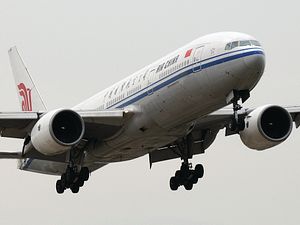Amid turmoil in China’s stock market and concerns about the health of the Chinese economy, bullish views on China’s long-term prospects appear refreshingly contrarian. Earlier this week, Boeing released its latest market outlook, which forecasts China’s domestic air travel market to become the largest in the world and China’s commercial aircraft fleet to almost triple by 2034. This opportunity for Western – and indeed Chinese – aircraft manufacturers, however, represents a significant competitive challenge for Western airlines.
Boeing’s View of the Chinese Market
Once a year Boeing updates its Current Market Outlook (CMO), which forecasts the development of the global aviation industry and global aircraft demand 20 years into the future. In its latest CMO for the years from 2015 through 2034, Boeing remains optimistic about the long-term development of the Chinese economy in general and China’s domestic aircraft demand in particular. For China, Boeing expects annual GDP growth of 5.6 percent and growth rates for passenger traffic and airfreight of 6.6 percent and 7 percent respectively, making China the world’s largest domestic air travel market. Boeing forecasts this growth to result in almost tripling China’s domestic commercial aircraft fleet, from 2,570 aircraft in 2014 to 7,210 aircraft in 2034. Including replacements for retired aircraft, this growth is forecasted to generate a net demand of 6,330 aircraft with a market value of $950 billion. China’s domestic widebody fleet is projected to grow from 460 aircraft in 2014 to 1,680 aircraft in 2034 or from about 18 percent to 23 percent of China’s total domestic aircraft fleet.
China’s Airline Industry
China’s airline industry, led by the Big Three state-owned airline groups – Air China headquartered in Beijing, China Eastern in Shanghai, and China Southern in Guangzhou – has benefited from strongly growing demand for air transport in China and has enjoyed annual passenger growth rates of around 15 percent until fairly recently. In terms of total passengers carried, China’s Big Three rank among the ten largest airlines worldwide (China Southern: No. 3, China Eastern: No. 7, Air China: No. 10). The success of China’s Big Three has been predicated on a business model that differs significantly from Western, particularly European, carriers. More recently, China’s Big Three have been confronted with competitive challenges similar to Western network carriers.
Profitable short-haul operations: Europe’s Big Three network carriers – Air France-KLM, IAG (British Airways, Iberia) and Lufthansa Group – have struggled to achieve sustained profitability in their short-haul operations and have engaged in extensive rounds of restructuring, including exiting from short-haul routes and transferring some short-haul operations to group internal lower cost subsidiaries. Financial performance of the European Big Three has been disproportionately dependent on the profitability of their international long-haul network. In contrast, the profitability of China’s Big Three is strongly driven by their domestic and regional short-haul operations, which, due to a combination of market and non-market factors, have often delivered higher yields than their international long-haul traffic.
Low share of international traffic: Given the profitability of their short-haul business, China’s Big Three have faced less pressure to invest in their long-haul networks than Europe’s Big Three. As a result, the international traffic of China’s Big Three accounts for less than 10 percent of their total passenger numbers. Whereas China’s Big Three rank among the world’s ten largest airlines in terms of total passengers (i.e. domestic and international passengers), none ranks in the global top ten as measured by number of international passengers carried.
Rise of domestic competitors: The growth of other full-service carriers such as Hainan Airlines Group, low-cost carriers, and high-speed railway has altered the competitive environment for China’s Big Three. The resulting net impact has arguably been less significant than the rise of Southwest Airlines in the U.S. or the growth of low-cost carriers and high-speed railways in Europe. However, these new domestic competitors and lower growth rates in China’s domestic air transport market are forcing China’s Big Three to adjust their business models.
Going Global in the Air
The more China is characterized by a “new normal” of a less rapidly growing economy that is driving less rapid growth in China’s domestic traffic and the more yields in this segment will come under pressure, the more attractive investments into international routes will become and the more Chinese carriers are likely to allocate aircraft capacity to growing existing and launching new long-haul services.
In fact, this trend of accelerating investment into international business already manifests itself in passenger numbers. During the first five months of 2015, in terms of passengers carried, the international regional and long-haul traffic of Chinese airlines grew 2.5 as fast as their domestic traffic. Also, for the first time ever, Chinese airlines are forecasted to operate more long-haul flights to the U.S. than American carriers to China.
It is important to note that although domestic short-haul traffic yields in China have come under pressure, the Chinese home market remains profitable for China’s Big Three. It is this advantage of being able to grown their international business on the basis of a sizable, growing, and profitable home market that makes Chinese airlines particularly challenging competitors, especially for European network carriers that depend on their long-haul networks to drive overall profitability.
China’s Big Three have used long-haul widebody aircraft such as the Airbus A330 for domestic and regional high-density routes. However, a significant share of the projected growth of China’s widebody fleet until 2034 is likely to be allocated to international long-haul services. China’s growth in aircraft demand over the next 20 years may be good news for Western aircraft manufacturers, but it’s likely to be bad news for Western network carriers.
Marc Szepan is an aviation industry executive currently on academic sabbatical at the University of Oxford where he is a doctoral candidate at Saïd Business School and a member of Green Templeton College. The views expressed in this article solely reflect his personal opinion.

































